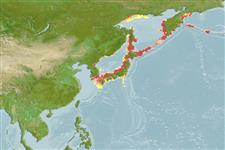>
Salmoniformes (Salmons) >
Salmonidae (Salmonids) > Salmoninae
Etymology: Salvelinus: Old name for char; it is the same root of german "saibling" = little salmon (Ref. 45335).
More on author: Pallas.
Environment: milieu / climate zone / depth range / distribution range
Écologie
marin; eau douce; saumâtre benthopélagique; anadrome (Ref. 51243); profondeur 0 - 50 m (Ref. 50550). Temperate; 60°N - 30°N, 127°E - 175°E
Northwest Pacific: Japan and northeastern Korean Peninsula through Sakhalin, the Kuril Islands to Kamchatka.
Taille / Poids / Âge
Maturity: Lm ? range ? - ? cm
Max length : 120 cm TL mâle / non sexé; (Ref. 56527); poids max. publié: 15.0 kg (Ref. 56527); âge max. reporté: 9 années (Ref. 56527)
The land-locked form prefers low temperature streams, below 15°C. Young of the sea-run form enter the sea at 2 years of age and return to the rivers for spawning when they are 4 years or older. Found in summertime water temperature of 13-15° C (Ref. 12218). Carnivore, feeding on insects and plankton (Ref. 12218). Utilized fresh, smoked and frozen; can be broiled, microwaved and baked (Ref. 9988). Two forms: the land-locked form which reaches 35 cm, and the ocean form of 70 cm (Ref. 9137).
Distinct pairing (Ref. 205).
Masuda, H., K. Amaoka, C. Araga, T. Uyeno and T. Yoshino, 1984. The fishes of the Japanese Archipelago. Vol. 1. Tokai University Press, Tokyo, Japan. 437 p. (text). (Ref. 559)
Statut dans la liste rouge de l'IUCN (Ref. 130435)
Menace pour l'homme
Harmless
Utilisations par l'homme
Pêcheries: commercial; Aquaculture: expérimental; pêche sportive: oui
Outils
Articles particuliers
Télécharger en XML
Sources Internet
Estimates based on models
Preferred temperature (Ref.
123201): 1.4 - 19.2, mean 5.1 °C (based on 106 cells).
Phylogenetic diversity index (Ref.
82804): PD
50 = 0.5000 [Uniqueness, from 0.5 = low to 2.0 = high].
Bayesian length-weight: a=0.00457 (0.00181 - 0.01153), b=3.10 (2.88 - 3.32), in cm total length, based on LWR estimates for this (Sub)family-body shape (Ref.
93245).
Niveau trophique (Ref.
69278): 4.4 ±0.7 se; based on diet studies.
Résilience (Ref.
120179): Milieu, temps minimum de doublement de population : 1,4 à 4,4 années (tmax=5; k >0.30).
Fishing Vulnerability (Ref.
59153): High to very high vulnerability (72 of 100).
